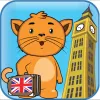Take a look inside 5 images
Kitty's Trip to Europe - United Kingdom - Geography for Kids
Pros: Engaging host teaches fun U.K. facts through an easily accessible interface.
Cons: Depth of information and interactive elements are inconsistent, don't always inspire.
Bottom Line: Basic introduction to U.K. culture; more depth, variety, and consistency would make it even better.
This very simple introduction to how people across the pond live can be useful for discussing geography, the world's people, and their cultural differences (even in countries as similar as the U.S. and U.K.). But information and games are somewhat superficial; teachers will likely want to supplement with further investigation, group/class discussions, stories, and more. Teachers might also let kids decide what interests them (e.g., food across the world), let Kitty give them a start on a cultural adventure, and then research what people eat in five other countries. Kids can report on what they learn in a class presentation, in pictures, or in writing.
On this journey through the U.K., Kitty introduces K-2 students to a variety of tidbits about U.K. geography (map), history (Big Ben), culture (monarchy, fish and chips, rugby), and literature (Robin Hood, Sherlock Holmes). Most of the 18 informational stops are interactive -- e.g., kids can fry fish and potatoes to make fish and chips -- and, at most, kids respond to a multiple-choice quiz question or play a brief game, like putting puzzle pieces together to make a double-decker bus or aiming Robin Hood's bow and arrow to hit a target. At several random points on the journey, Kitty opens a gift box containing an article of clothing; at the end, Kitty is dressed in an ostensibly British outfit. Teachers can create multiple user accounts; each user's progress is saved across play sessions.
Kitty is an appealing guide for a little adventure through the U.K. Many topics, such as castles, food, sports, and story characters, should pique kids' interest. Gameplay is simple and accessible, even for young kids. A fine line exists between providing enough depth and overwhelming young kids with too much information, however, and many of the tidbits, despite demonstrating a great approach and appropriate language, lack depth or some common thread that could tie everything together. Interactive elements are fun, but seem random, which might confuse kids. For example, some information stops are interactive, some aren't; some have an interactive quiz or game, some don't. Available games and quizzes are an engaging start, but could use more variety (many are repeated multiple times), depth, or explanations (some quizzes cover information not previously discussed).












